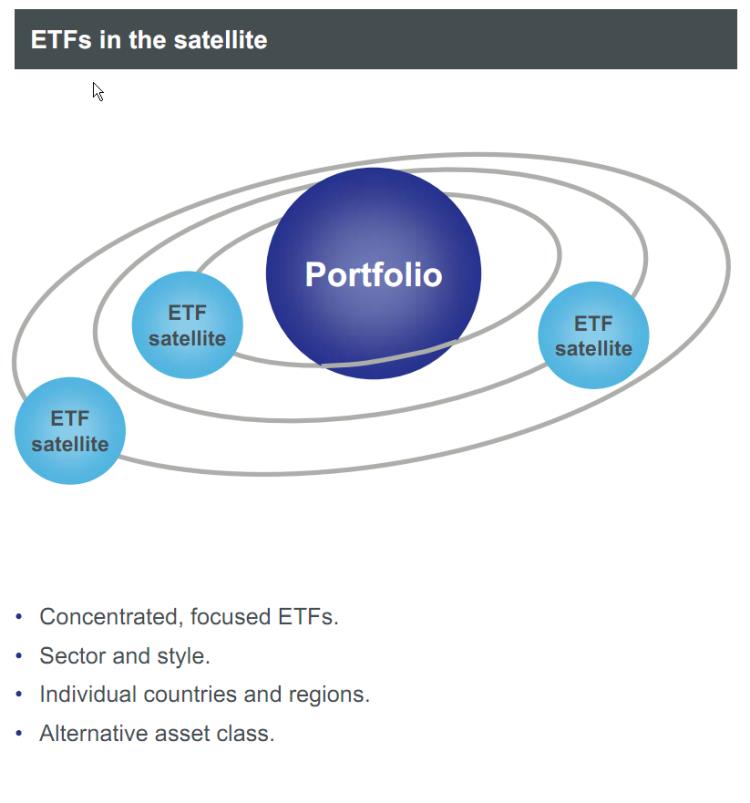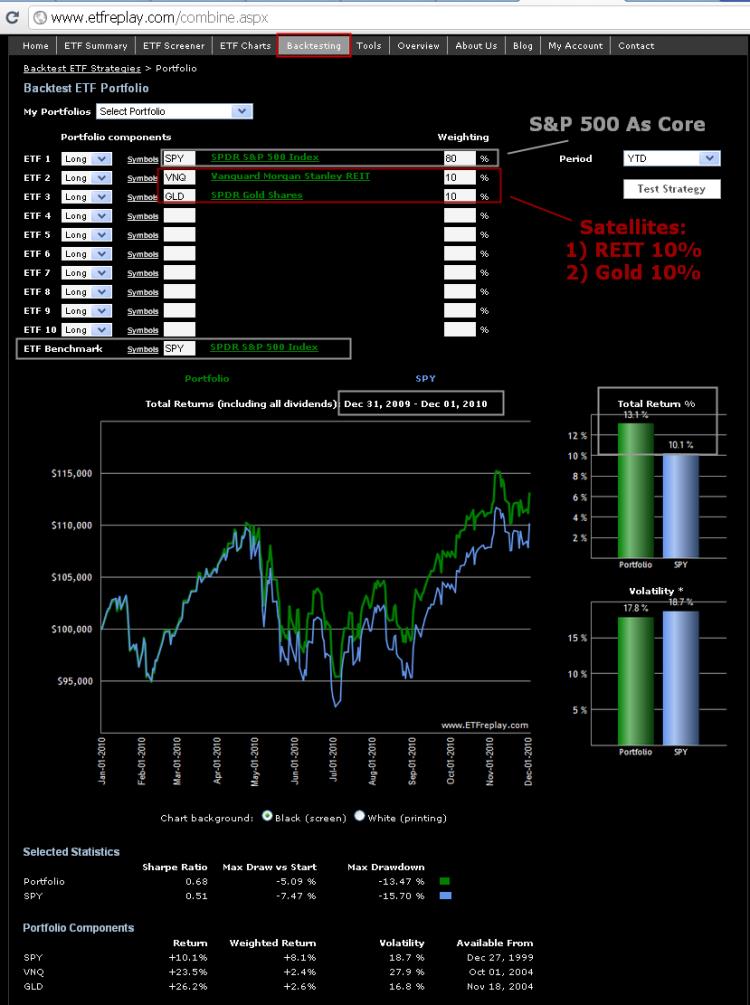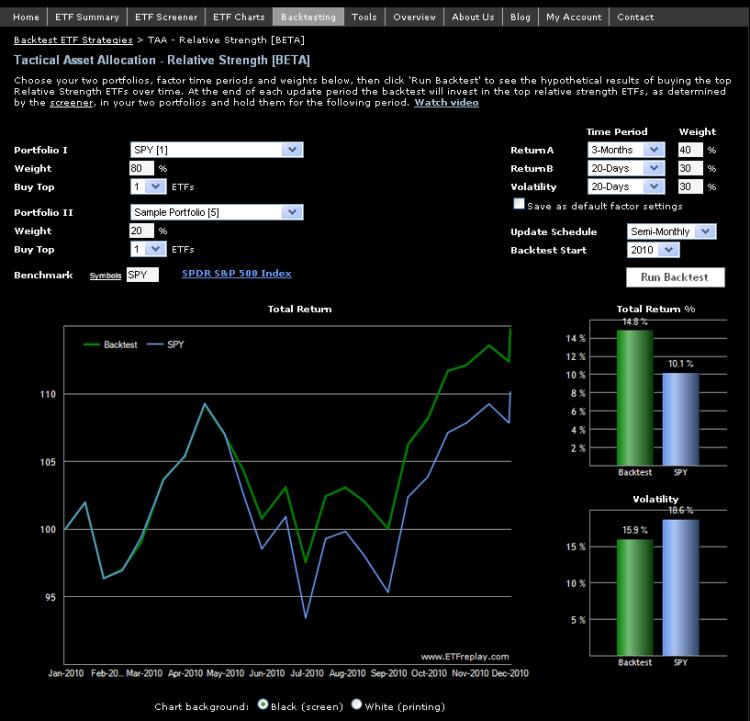Core-Satellite ETF Techniques Introduction
Dec 02, 2010
in Relative Strength
Charles Schwab recently published some summary statistics on their accounts. They said that while 90% of accounts own individual stocks – just 15% of accounts hold ETFs. So while many people may have been using ETFs for many years now, using Schwab as a proxy, about 85% of people still need some introduction to ETFs.
There are 3 basics schools of thought on active management in general:
- Those that think it’s impossible
- Those that think it’s easy
- Those that think it’s a challenge -- but rewarding
For those that think passive management is the way to go, your job is still not over. You will still need to figure out an asset allocation. “Just buy index funds” actually doesn’t get you far --- there are over 1000 ETFs that follow various indexes and there is no single answer to what exactly constitutes a passive strategy. I can’t imagine there exists a professionally trained investment advisor who advises putting 100% of money into a S&P 500 index -- but I guess never say never. So absent that, there are still allocation decisions to be made about stocks vs bonds -- as well as the mix of international stocks and how much to include in alternatives like REITs & Precious Metals. These are all classic passive indexing discussion points.
For those that think like #2 above – that active management is easy, this crowd is likely just plain dangerous. They simply ‘don’t know what they don’t know.’
The third group acknowledges the challenge and comes at the issue with some humility. We sit firmly in the 3rd camp. It takes some analysis and testing and hard work to do well in investing. You don’t need to just come up with ideas – you need an investment PROCESS. That is, some type of structured approach.
So let’s introduce the core-satellite approach. It’s excellent for its flexibility in balancing return & risk. Here is a visual that Blackrock has used for this:

Source: Blackrock
What makes this framework really powerful is that you can pursue more aggressive strategies --- but still rein in the overall risk of a portfolio. You can stay within your specific risk tolerance but still buy/overweight some attractive (but perhaps more-volatile) segments. Or perhaps you are an advisor and your clients have different risk appetites. You can use your same ideas across these different accounts but just change the allocations between the conservative core and the more aggressive satellite strategies to more precisely target the appropriate risk-budget.
A typical investor thought might be --- I like the idea of investing in Emerging Asia – but how do I do it? How do I think about the risk involved in the short-run if and when some problem emanates out of South Korea or India or China?
So for a very basic start, let’s mix the core idea of completely passive-indexing with just 1 or 2 actual ideas. In this example, rather than invest in just the benchmark S&P 500, we will invest 80% in the S&P 500 and 10% in each of two other market segments --- Real Estate Investment Trusts and Gold.
Below is a look from our free Backtest Portfolio app to observe how this portfolio looks Year-To-Date (total return):

Note the 3 percentage point pick-up in performance this year for some pretty simple ‘tilts’. Importantly, note also that there has been some diversification benefit (reduction in volatility). Other than returns being better, the core-satellite portfolio went down less over the summer. So it went down less and yet has added 3%. Your tilts added significant value here. Not bad for a start. But we can do better.
If you are a registered user on the site – whether you registered 8 months ago or yesterday – you may have noticed you had 1 starter portfolio we created called ‘Sample Portfolio.’ Rather than use REIT’s and GLD as our satellite strategies, what if we instead used this sample portfolio top relative strength pick as 20% of the portfolio. Here is that example using our new Advanced RS Application (for subscribers)

Notice that the result here is +14.8% return with even more diversification benefit (it went down even less during the summer correction). Remember, it is 80% S&P 500 in the first place so this is actually an excellent result. Standalone, this ‘sample portfolio’ that we created in the Spring time has had a banner year --- see for yourself within the portfolio backtest app.
As you will see when using the TAA application – and as we will discuss in upcoming blogs, you can change the percentage allocations from the core to the satellite and back to the core and see how it affects the overall results -- not just in returns but in ‘smoothing out the ride’ with lower volatility. This is the very essence of TAA.
All of this is just a start for those who are new to ETFs. We have many more options available in this core-satellite framework. A more conservative investor – perhaps older and less willing to take even average risk --- could start with a bond-only core portfolio and then add equities as satellite strategies. Or we could start with a more diversified core (say mixing REITS & Gold & Junk Bonds in the core) and then add country or sector funds in the satellite(s). These and other ideas will be future blog topics.
Follow ETFreplay on
